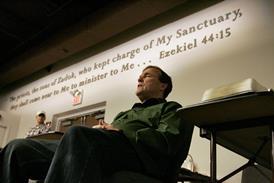While Veronica Zundel reminds us Jesus taught we will be judged by how well we lived the Christian life, rather than our church style, she believes that there is room for all the different types of church in existence today
When I was single and lived in central London, I attended the local parish church, which shared a vicar with the next parish. The church I belonged to was traditionally ‘low’, while the other parish was regarded as ‘high’. I vividly remember a salt-of-the-earth member of my church saying: “We’re Protestant here, they’re Anglican up at the other place”! They were both Church of England, but to her they might as well have been different denominations (eventually the two parishes merged by special permission of the Queen, and all worship moved to the ‘high’ parish where we continued with our essentially middle-of-the-road style).
Why do we have so many different denominations and even divisions within one denomination? Is it a blot on the face of the Church, a failure of unity or a case of, to borrow a phrase from Chairman Mao, “let[ting] a thousand flowers bloom”? I started out my faith journey in a broad Baptist church, became an accidental Anglican at university, hung around with Lutherans a lot, spent 24 years – a third of my life – as a Mennonite (and still very much identify as one) but am now worshipping with a lovely little inclusive Methodist congregation. I’m a walking ecumenical movement, me. Yet I was still shocked when I discovered that there were as many as 20 different Mennonite groupings in the USA, although the two main ones have merged since then. As for the Amish, they manage to divide over such deep biblical issues as whether you can have a chrome bumper on your horse-drawn buggy or have to have a modest black one.
Different perspectives
It’s really only since Martin Luther nailed his 95 theses to the church door in Wittenberg and started the Reformation that the Church has displayed such fissiparous (look it up) tendencies. The Catholic Church has a genius for allowing new movements to start under its wing (look at all the different monastic traditions) and yet somehow keeping them all together. Although having said that, the Catholic Church is itself the product of a break with the Orthodox Church – or the other way around, depending on which side you view history from.
There’s a cartoon going round social media in which a teacher is showing his class a complex diagram of church splits through the ages, laid out like a family tree with all its branches, and he points to a tiny branch at the very end of the line and says: “And this is where our lot came along and got it right.” Is there really a ‘true’ Church? Or are there just lots of different perspectives, each of which has a fragment of the truth?
Catering to different tastes
I’ve enjoyed aspects of all the church traditions I’ve been in, though I felt most at home in the Mennonites. Like my second-oldest friend, whom I still get on with after 65 years, I have an Anabaptist (that’s the movement the Mennonites come from) ecclesiology or view of church life, and warm to Anglo-Catholic liturgy. Funnily enough when I was explaining the Anabaptist approach to scripture to the Anglo-Catholic priest of my last Anglican church, he exclaimed: “But that’s exactly the same as the Anglo-Catholic approach!” It’s what my husband calls ‘wraparound world’, where the two ‘extremes’ end up meeting in the middle.
All these splits are human nature of course. The Communist/socialist movement is a mirror image, with its many divisions and sub-groups. We all want to get it right, and if we focus our attention on right doctrine, rather than right living, we are even more likely to disagree. It’s inevitable when we hold our beliefs passionately and see them as a matter of life and death. Yet I can’t help thinking that an awful lot of these disagreements are quite simply a matter of taste. Some like worship to appeal to their senses (the ‘bells and smells’ brigade) and some want to worship with their minds, regarding the sermon as the climax of a service, while others give that place to the communion (or the Lord’s Supper, or Eucharist – whatever your tradition calls it). Ultimately, we are whole human beings and need to worship with both. I got into trouble the other day on social media when I compared ‘happy-clappy’ worship unfavourably with Choral Evensong on Radio Three. Quite rightly, people pointed out that charismatic worship does it for some who are left entirely cold by Choral Evensong.
Just as different clothes shops cater to different women, so perhaps different churches cater to different Christians. Jesus said in Matthew 25:31-46 that we would be judged not by what we believed or our worship style, but by how well we lived the Christian life. Let a thousand flowers bloom.

































No comments yet